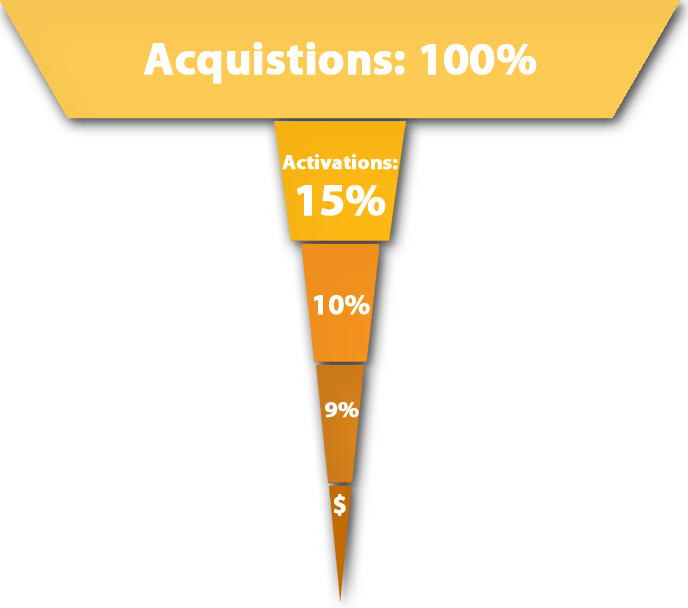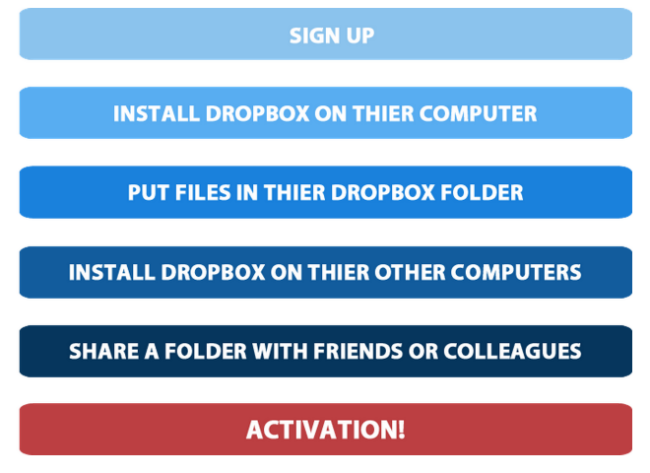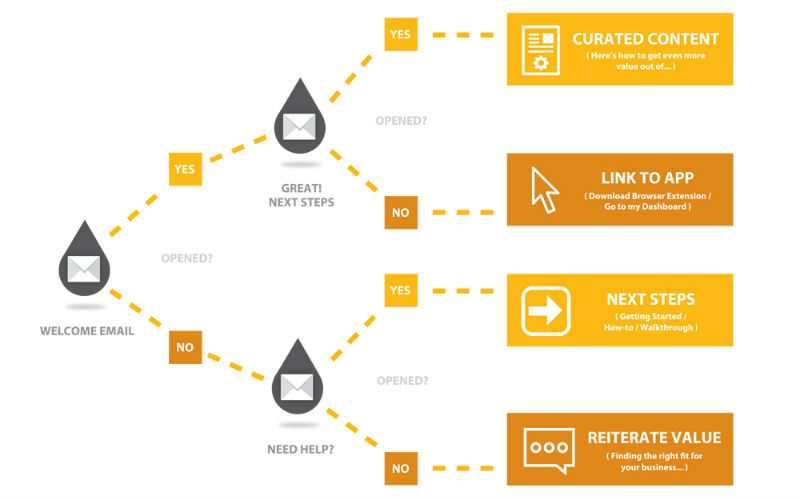Pirate metrics: how to create an email campaign based on the AARRR principle. Part 2

On Pechkin's blog on Habré, we write a lot about interesting techniques for working with email newsletters . Earlier, we considered common mistakes when creating forms in mail letters, and today we bring to your attention an adapted translation of the note from the Sendwithus service team about which approaches to the development of letters help to increase their conversion. The first part of the material can be read here .
Introduction
By sending welcome letters, you have gained the trust of your new users. They are familiar with your product and show an active interest in it. Now you need to make sure your customers use your subscription. And this will help you activation letters and onboarding.
')
What is activation?
Activation occurs when users fully understand the value of your product. Just like the attraction phase, the activation phase does not happen instantly. The mere fact that you received someone's email address does not mean that this user is "activated". Even if the user immediately starts using your product and benefiting from it, he may still need support to complete the next step.
Activation is a difficult process. Just remember all the free trial versions of the products that were provided to you by subscription. Now calculate how many companies you really paid.
The bottom line is that you do not use the product not because of a bad value proposition. The problem is in the “entrance barrier” - to master the use of a new product always requires a lot of extra time and energy.
To help new users overcome the activation phase, we use onboarding newsletter. In these letters, users are told about what to do next, and about the value of the product for the client. In the first weeks after the subscription, users are basically sent just such letters - “starting to work with us ...”, product presentations or guidelines for their use.
So, which stage of the funnel in the “pirate” model are we in?
After all the time and energy has been spent on finding new subscribers and attracting their attention in the first stage, it is necessary to make sure that they get the first positive experience.
Like many startups in the early stages, your “pirate funnel” [conversion] might look something like this:

You attract more and more customers (the upper part of the funnel), but only some of them go to the second stage - the use of the product.
Take the horse to the watering hole
To activate new users, you need to understand what the obstacle is between subscription and effective use of the product. Regardless of what an obstacle is, whether it is a confusing user interface (UI), vague goals [activation], or if the client doesn’t get the result from working with you fast enough, your task is to help users overcome this stage without problems. The most effective way is via email.
Well, I know what you're thinking right now: Email ... onboarding ...
“I'll start with a drip marketing campaign!”

Many startups are not ready for “drip” marketing.
While we were writing the text for this chapter, we talked to our friend Noa Kagan from AppSumo , and he gave us a bright idea: if you don’t know exactly what will happen as part of the drip marketing campaign, you are wasting time in vain. You should take this strategy as a way to automate the most difficult stages of activating a new user, so first of all you need to figure out what these difficulties are.
“How?” - you say? Just ask the users themselves.
You can learn about the difficulties in the last chapter of this article, but you have not read it yet. Direct, personal communication is a huge advantage not only at the stage of building relationships with new users, but also at the stage of clarifying the difficulties that your users face, so you can correct problems that arise and write about it in the onboarding mailing list.
CEO: Your task is to write the first thousand customers
Previously, Rob Fitzpatrick wrote a wonderful post in which he offers CEO start-ups to personally write letters to the first thousand customers, make sure that customers are satisfied and actively use the product. Users will not only be happy to talk with a real person, but you [CEO] will know the wishes of their clients, their problems and how they can be solved.
Rob's letters are ordinary and short, but they offer tremendous development opportunities for the client. Such letters help identify problems in support and maintenance, and at the same time interest potential dedicated users to your product.
Answering the same questions again and again, you will understand what users want and what prevents them from achieving it. When you get tired of answering the same questions - only then, consider that you are ready to create a cool onboarding newsletter.
Create onboarding newsletter
Step 1: Sketch Outline
In the previous chapter, we identified the main activation objectives in order to develop clear and effective welcome letters. Now the next step is to lead the client to make a purchase (onboarding) according to the funnel scheme. The conversion funnel will help you determine where in your onboarding process there are unnecessary or optional actions [that tire the client] - working with her you will understand at what point after the welcome letter you should send the onboarding message to the user.
The conversion funnel operation algorithm consists of three steps:
- Determine the main goals of activation;
- Identify the main problems;
- Find a solution to problems;
But, before we create a funnel, you need to understand two things: the goals of activation and the motivation of the user.
Understanding the goals of user activation and motivation
Customer motivation is why people use your product (your value proposition). For Facebook, it’s an opportunity to connect with old and new friends. And for DropBox - an easy way to share access to files and work with them from different devices.
Activation goals are all actions that users must complete in order to go from the first stage (subscription) to the desired stage (their own purpose of using the product). For example, installing software, learning the user interface, chatting with friends, or downloading a file.
Activation occurs when users fulfill all of the [goals] you have planned and get what they want. The fewer actions required for this, the better.
Let's build a conversion funnel using the example of Dropbox.
Defining the main goals of activation
New users register with Dropbox because it is an easy way to work with files on different devices and share them with friends and colleagues. However, each user must pay attention to several steps (activation goals) in order to use this service.
If we needed to identify all the activation goals between the subscription stage and the stage of direct use of the service, then the main goals would look like this:

Registration - Install Dropbox on your computer - Drag and drop files into Dropbox folder - Install Dropbox on other devices - Set up access to the folder for other devices (for friends, colleagues) - Activation done!
Identify the problem
Now that you've come up with activation targets for the conversion funnel, it's time to track the statistics to determine which of the [goals] causes the most problems for users.

If you look at the percentage of conversion in the picture above (we invented them, by the way), you will see that the lowest mark at 16.2% corresponds to the goal of “Install Dropbox on your computer”, and all other goals have a conversion rate higher than 75%.
If you keep statistics on how many users fulfill each of the activation goals, you will be able to identify the problem much faster.
Finding a solution to the problem
As soon as you find out which of the goals your users “drop out of the funnel,” you need to fix this. Here you need to investigate the situation. Sometimes the cause of the problem will be on the surface - maybe you just need to send more reminders, and sometimes you have to study user experience in depth to find the cause.
In the case of Dropbox, the creators could see a low conversion rate during the installation of their application and assume that the registration results should send users a letter describing the features of the product with a noticeable clickable link to download their application.

Step 2: Write the text onboarding mailing
We all received onboarding messages. They are not only useful, but also assertive, annoying and sometimes even desperate.
Worst onboarding messages have one thing in common - they are fully focused on increasing their conversion: “How would we sell it?” Or “What can we offer a client to make a purchase?”
This is the wrong approach.
Onboarding messages work best if they have value for the subscriber. Your onboarding messages should correspond to the activation process (activation goals) - find out directly from the user what problems he has encountered. Then, when you need to come up with a solution, you will already know exactly what users are looking for.
Leave the sale for later
Your users are not yet ready to make a purchase decision.
According to Gleanster , about 30-50% of leads already know something about your product, but are not yet ready to make a purchase. They still need to “lead” and “train” in order for them to fully realize the value of your product or service.
Once you have decided on the most useful information resources for your users, the following strategies will help you create letters that will turn your knowledge of their desires and problems into a kind of “bridge” between registration and activation. Remember, new users are ready to read your emails as long as you send them relevant content.
Strategies for composing onboarding messages
Leave the only clear STA-button in the letter
This advice is repeated from the first chapter on welcome letters. We write about it here again, because the success of the mailing depends on a simple and clear CTA button. Readers are more likely to follow the link when they know what the next step will be.
Buffer, a service of postponing posting in social networks, begins its onboarding campaign with a letter with a CTA button, which, when clicked, sets up their browser extensions, which takes users one step closer to activation.

The letter makes the next step in the activation process obvious, and also contains a proposal for assistance in resolving issues that might arise during the previous stages.
Create or publish relevant content.
Onboarding messages should educate users, not ask them to buy your product. It doesn't matter if you recorded a video, or wrote a blog post, or placed a link to relevant content - it is important to share these materials with your subscribers, if you are sure that this will help them use your product or service. And remember, choose content that will support their feeling that they did the right thing by registering.
Buffer sends great cover letters that are hard to miss if you recently signed up with a service that helps you succeed in social media.

Attach direct links to your application.
Make sure that newly registered customers can immediately start using your product or service. If you can give a direct link to your application, by clicking on which the user immediately enters your account and starts work - do so. Do not demand from the user unnecessary or unnecessary actions in their onboarding messages.

One of the latest onboarding messages from Buffer once again reminds of the value of their product and makes it possible to immediately start using it.
Determine the time of sending your messages
There are two slightly contradictory concepts that you need to know when setting up a schedule for sending your onboarding messages (an interesting post with statistics, including on this subject, we published on Pechkin’s blog earlier ):
- "Strike while the iron is hot"
- "It's a marathon, not a sprint."
"Strike while the iron is hot"
Plan a user experience. Users are most interested in your product when they have just registered, and over time, interest becomes weaker.
If users do not actively interact with you during the onboarding process on the first day, send more information about the product or offer them assistance in setting up their account. Even if you are a start-up startup, you can easily afford to do things that will be difficult to scale in the future, only to attract future “evangelists” of your product.
"It's a marathon, not a sprint."
Activation does not happen instantly.
The user may get angry quickly if he receives a ton of onboarding messages from the company. Check the conversion funnel once a week or two and write to users who have not achieved any activation goal.
The method you should choose will depend on your user base. Try both methods. You will quickly find out which one works and which one doesn't. The main thing is not to leave your users. Once they have registered, they are ready to read your letters as long as you send them the necessary and interesting content.
Step 3: Automate your user research method using drip marketing
As soon as you have independently led the first users to the activation stage, you can summarize all the knowledge gained and then automate this process with the help of a drip marketing campaign. This will allow you to set up a system that has already proven its performance, so that new subscribers automatically receive the right information at the right time.
The standard drip marketing scheme is as follows:

“Drip” marketing automatically segments users into groups, pushing them down the conversion funnel to send the information they need for the activation process. The marketing strategy takes into account the characteristics of each user segment and the time when they should write to make sure that as few subscribers as possible “drop out” from the funnel. However, a drip marketing campaign will be successful just as much as you yourself make it so - this is just a tool, not a solution to the problem.
All good “drip” marketing campaigns should be invented by a marketer or a CEO who understands the real state of a new user. Without an understanding of the characteristics of each user segment, “drip” marketing is just a shot at random.
Conclusion
Activation is a key stage of the “pirate” model. At this stage, you fulfill the promises made by you at the stage of attraction, and test your product on real customers. Activation does not happen instantly, but if people spend their time to register, your job is to make sure they get a positive user experience.
If you want to take advantage of the strategies in this chapter, then remember that in order to succeed you must listen to your users. Communicating with users will help you understand the desires and problems of your subscribers, and how you can help them solve them. If you understand this, the onboarding process will work fine.
Source: https://habr.com/ru/post/269775/
All Articles